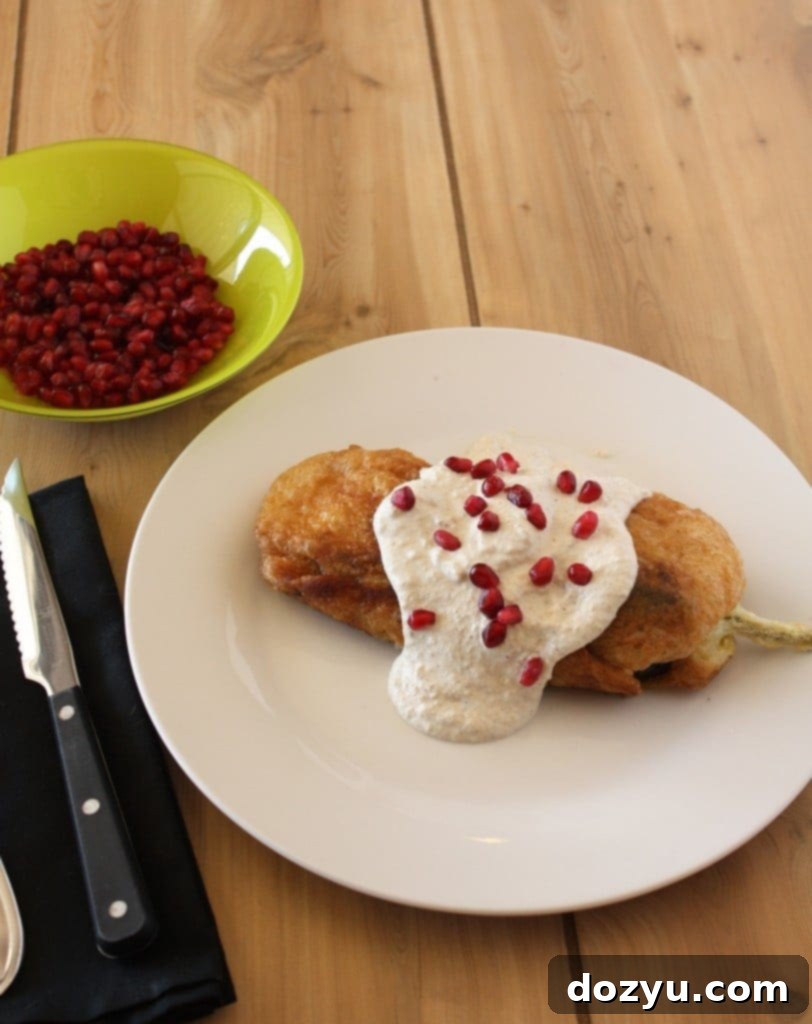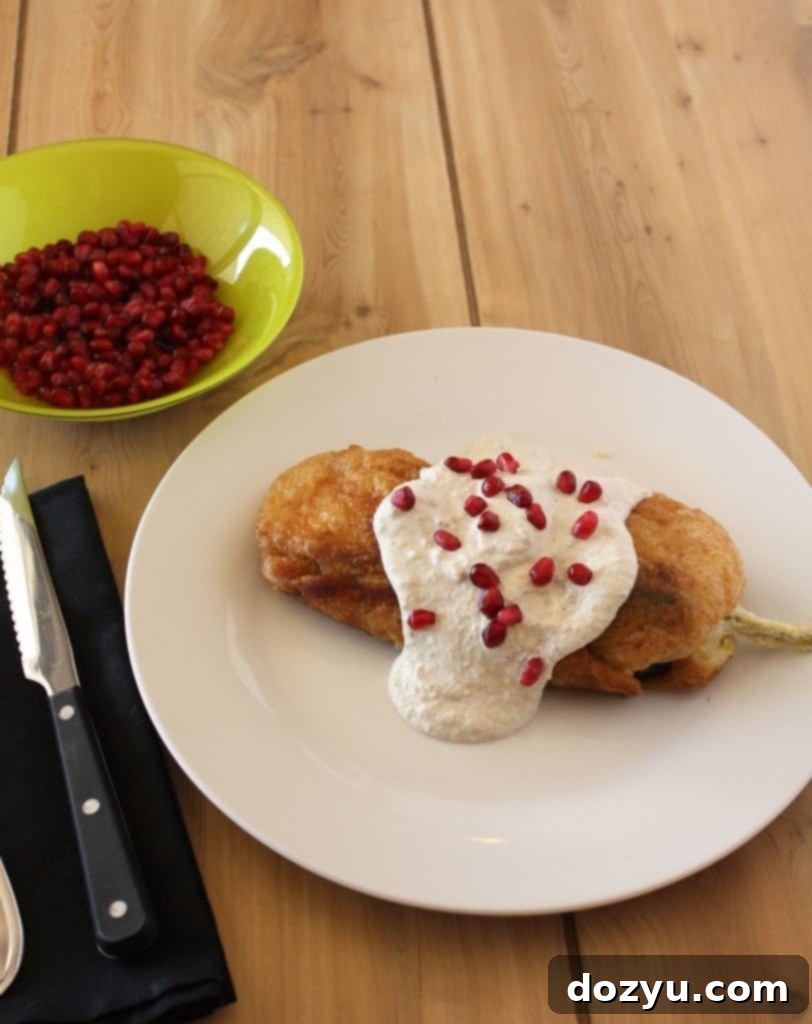Chiles en Nogada: Discovering Mexico’s Patriotic Culinary Masterpiece & Authentic Recipe
Prepare to embark on a culinary adventure that promises to surprise and delight your palate like no other. Chiles en Nogada is not just a dish; it’s a vibrant celebration of flavors, textures, and history, encapsulating the very essence of Mexican gastronomy. When I first encountered this iconic recipe, I confess, I was utterly bewildered by its unique combination of ingredients. Sweet fruits, savory meats, aromatic spices, and a creamy, rich walnut sauce all come together in a way that defies conventional expectations. I read and reread the list, wondering how such disparate elements could possibly harmonize.
The moment I took the first bite, any skepticism vanished. It was an absolute revelation – a symphony of sweet, savory, and subtly spicy notes that danced on my tongue. The experience was truly extraordinary, unlike anything I had tasted in a long, long time. This dish doesn’t just taste good; it tells a story with every mouthful, unfolding layers of flavor that are profoundly satisfying and utterly unforgettable.
The Rich History and Patriotism Behind Chiles en Nogada
Chiles en Nogada holds a deeply revered place in Mexican culture, particularly in Puebla, its vibrant birthplace. This magnificent dish is a powerful symbol of national pride, embodying the three colors of the Mexican flag: the verdant green of the poblano pepper and fresh parsley, the pristine white of the luxurious walnut sauce (nogada), and the vivid red of the pomegranate seeds. It was first created by the Augustinian nuns of the Santa Monica convent in Puebla in 1821 to celebrate Mexico’s newly won independence and to honor Agustín de Iturbide, who visited Puebla after the signing of the Treaty of Córdoba. Traditionally, it makes its appearance on Mexican tables during the late summer and early autumn months (August and September), when pomegranates and walnuts are in peak season, making it a truly seasonal delicacy and a testament to Mexico’s rich culinary heritage. The best part is this dish is still prepared much the same way as it was over 200 years ago, a true culinary legacy (excluding the obvious help of modern kitchen appliances, of course!).
A Culinary Challenge Worth Conquering: Tips for Mastering Chiles en Nogada
While preparing Chiles en Nogada might seem like stepping a bit outside your culinary comfort zone, and it certainly takes a moment to master techniques like perfectly frying the peppers, the reward is immense. Once each element is thoughtfully prepared and elegantly presented on the plate, it comes together in a truly beautiful and harmonious way. This isn’t an “easy” dish in the sense of a quick weeknight meal, but it’s far from being so technically advanced that an amateur couldn’t master it with a little dedication.
The key to success lies in two fundamental principles: patience and meticulous preparation. Before you even think about turning on the stove, ensure all your ingredients are chopped, peeled, minced, and prepped (this is often referred to as “mise en place”). This methodical approach will transform a potentially overwhelming recipe into a manageable and enjoyable cooking experience. For instance, mastering the charring and peeling of poblano peppers, while delicate, becomes much smoother when you’re not rushing. The process involves gently rubbing the skin off with your thumbs or a paper towel after the peppers have rested, taking care not to tear the peppers which will later be stuffed. Don’t fret if a few small pieces of skin remain; it’s notoriously difficult to remove every last bit, and it won’t detract from the flavor or experience.
The Heart of the Dish: Picadillo Filling and Velvety Nogada Sauce
The core of Chiles en Nogada lies in its picadillo-style filling—a complex symphony of sweet and savory elements. This intricate mixture typically combines ground pork and beef with an array of diced fruits such as peaches, apples, and pears, along with raisins, almonds, and pine nuts. Spices like cinnamon, clove, and thyme infuse the filling with an exotic warmth, creating a truly unique flavor profile that is both unexpected and incredibly harmonious. Each ingredient plays a crucial role, contributing to a multi-layered taste experience that will leave you wanting more. Preparing this filling ahead of time, as many traditional recipes suggest, allows the flavors to meld and deepen, making the final dish even more spectacular.
Crowning this masterpiece is the exquisite ‘nogada’—a creamy, delicate sauce made from fresh walnuts, goat cheese, milk, and a hint of sherry and sugar. The walnuts are typically peeled to remove any bitterness, resulting in a smooth, rich, and slightly sweet sauce that beautifully balances the savory and fruity notes of the picadillo-stuffed chiles. The coolness and creaminess of the nogada provide a delightful contrast to the warm, fried pepper, making each bite a revelation. For a food enthusiast like me, this recipe is absolutely wonderful – it seamlessly incorporates the rich history of Mexico with a captivating set of ingredients that I would never have thought to combine on my own. It’s a genuine culinary education and a pure delight.
Embrace the Journey: An Unforgettable Mexican Culinary Experience
While the ingredient list might seem extensive and the preparation slightly more involved than your everyday meal, Chiles en Nogada is a profoundly rewarding dish to create. It’s a true labor of love that connects you to centuries of Mexican culinary tradition. The intricate dance of flavors – the mild heat of the poblano, the sweet and savory picadillo, and the luxurious, cool nogada – culminate in an unforgettable dining experience. Do not let its complexity deter you; instead, embrace the challenge, prepare your ingredients with care, and allow yourself to be transported by this truly magnificent dish. Trust me, the effort is not just worth it; it’s a delightful journey for any culinary enthusiast. Dive into the authentic Chiles en Nogada recipe below and discover why it remains one of Mexico’s most cherished culinary treasures!

table of contents
Toggle
Chiles en Nogada
ingredients
- 1 to 2 tablespoons olive oil
- 1 medium onion chopped
- 2 garlic cloves minced
- 12 oz pork loin chopped
- 12 oz beef rump roast chopped
- 1 lb. charred tomatoes feel free to use the fire-roasted canned tomatoes if you don’t want to char your own tomatoes
- 1/2 cup raisins
- 8 oz peaches approximately 2 large peaches, peeled, cored and chopped
- 9 oz apples approximately 4 small, I used Gala apples, peeled, cored and chopped
- 8 oz pears you can use Mexican pears if you can find them, however I used Bosc pear and it tasted great
- 1/2 cup sliced almonds
- 1/2 cup pine nuts
- 3/4 cup candied pineapple chopped
- 1/4 teaspoon dried thyme
- 1/2 teaspoon oregano
- 3/4 teaspoon ground cinnamon
- 1/2 teaspoon ground clove
- 12 poblano peppers
- 3/4 to 1 cup flour
- 8 eggs separated
- Salt
- 1 bottle vegetable oil
- 4 cups whole peeled walnuts
- 3.5 oz goat cheese
- 1/2 cup plus 2 tablespoons milk
- 2 tablespoon sherry
- 2 tablespoons sugar
- 1/2 cup whole or chopped parsley leaves
- 1 cup pomegranate seeds
instructions
-
Start by making the filling. Heat the olive oil in a medium saucepan over medium heat. Add the chopped onion to the pan and cook until softened, approximately 3 to 4 minutes. Stir in the pork and beef and continue to cook until the meat is browned and almost cooked through. Add the tomato sauce and bring the mixture to a boil. Once it is boiling, stir in the raisins, fruit, nuts, dried pineapple, and spices. Make sure you taste the mixture at this point and add salt if needed. Bring everything back to a boil, then reduce the heat to low, cover the pot, and simmer for approximately 30 minutes. I took the advice of the original recipe and made this filling the day before and stored it in the refrigerator until I was ready to make the rest of the dish. If you do this, make sure you warm up the filling before you start assembling the rest of the recipe.
-
To char the poblano peppers, turn your broiler on high. Line a baking sheet with aluminum foil and place the peppers on the sheet. Char under the broiler for about 5 minutes per side – you will see the skin start to turn dark and bubble. Remove from your oven and let the peppers rest until they are no longer too hot to touch. To remove the skin, gently (I stress gently) rub the skin off with your thumbs or using a paper towel. Try to be as delicate as you can in this process so you don’t rip them apart. Don’t worry if you have a few pieces of skin still lingering on the peppers (it’s difficult to get it all off, I certainly haven’t mastered that art yet!).
-
Cut into one side of the pepper from the top to bottom, making sure that you leave a little space on either side so the pepper doesn’t split open while frying. Using a spoon or your fingers, remove the seeds gently (no scraping!).
-
Grab your filling and stuff each pepper with the filling until they are full but you can still close the opening. Then cover them all in a light coating of flour. Set those aside for a minute while you prepare the egg batter.
-
A key part of this recipe is timing. If you let the egg batter rest for too long, the texture will be off and you won’t get the right result. It’s a good idea to have everything in place, ready to fry, before you make the egg batter. While you are making the batter, go ahead and start heating up your oil in a medium skillet over medium-high heat. To make sure you are using enough oil (and not too much), pour in enough oil to cover the base of your skillet and be about 1/2 inch deep.
-
To make the egg batter, beat the egg whites with an electric mixer until they form firm peaks. Stir in the egg yolks one at a time just until they are incorporated into the egg whites.
-
Line a baking sheet with paper towels for the peppers to rest on once they have been removed from the oil. Now comes the trickier part of the recipe. Take one pepper and hold it on either end. Dip the pepper into the batter until it is covered in the batter. Carefully place the chile in the hot oil. If some of the pepper is still showing on the top, spoon some extra batter on top so it is completely covered.
-
Fry the pepper until it is golden brown, which happens fast, approximately 10-15 seconds. Using two spatulas or large spoons (whatever tool you have to do the job), roll the pepper over to cook on the other side. I ended up also enlisting the side of the skillet to push the pepper up against – it helped a lot! Fry for an additional 10-15 seconds and remove from heat to the lined baking sheet to drain. Repeat with the remaining peppers, you may need to add more oil to keep the same level in the skillet.
-
Last step! Prepare the sauce. Add walnuts, goat cheese, milk, and sugar to a food processor or blender. Note: if your blender or food processor is on the smaller side, you may need to split the ingredients and make the sauce in two batches. Puree/blend until the mixture is smooth. If the sauce is too thick, add one tablespoon of milk at a time until you reach a more sauce-like consistency. Add the sherry and puree/blend until combined.
-
Serve each pepper immediately with a good helping of the nogada sauce and top with pomegranate seeds and parsley.
